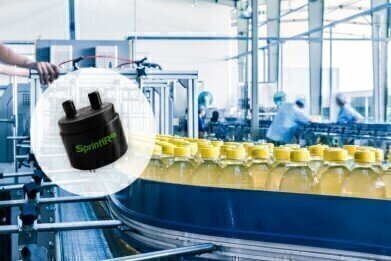Gas Detection
Battery-powered NDIR CO2 Sensor. Ideal for Industrial Applications as can Monitor up to 100% CO2 Concentrations
Jun 26 2017
Stand 922, Sensors Expo 2017, San Jose, USA
28 - 29 June 2017
Gas Sensing Solutions (GSS) Ltd, the LED-based CO2 detector specialists, will be demonstrating its new, ultra-fast SprintIR6S at Sensors Expo 2017 in San Jose, USA. GSS' unique SmartIR™ technology has enabled it to create a sensor that can take up to 20 readings per second, with a six times faster response rate than the current SprintIR* due to it having a sample volume of only 2ml. The SprintIR6S is available to measure CO2 concentrations right up to 100%, providing a cost-effective solution for high concentration monitoring that previously needed very expensive detectors. The ultra-fast response is particularly relevant in industrial applications to monitor that the correct, high levels of CO2 are being used.
"In many industrial applications, it is often vital to monitor CO2 levels," explained Alan Henderson, GSS' Founder, "to check that an elevated level of CO2 is being maintained at the right concentration for the process or product. In this respect, the SprintIR6S provides almost instant measurements - more than 20 readings in a heartbeat."
An example is the Food Packaging industry, where high levels of CO2 are used to keep food, such as sealed packages of meat and bagged salads, fresher for longer. On the production line, a sensor is needed to measure that the bags are being sealed with the correct level of CO2, which can be up to 100% concentration. The sensor must be able to work on small sample volumes and produce a result very quickly. The SprintIR6S needs less than 2ml of sample gas and can produce a reading in a fraction of a second. Waiting minutes for a reading of a sampled bag can result in many bags being processed incorrectly before the fault is noticed and corrective measures instigated on the production line. Until LED versions became available, CO2 monitors for these concentrations of 20% to 100% were the province of expensive specialised instruments.
"Low CO2 concentration sensor solutions are also particularly important to monitor for any leaks in these industrial settings," added Alan Henderson. "For this, we have a range of ambient air CO2 monitors that work in the 0 to 1% concentration range that are so low power that they can run for 10 years on a single battery. Increases in CO2 levels can rapidly have a negative effect on people, with alertness being increasingly compromised. Our sensors provide a vital early warning. 400 parts per million (ppm) is the normal level of CO2, and effects start from 1,000 ppm with drowsiness and yawning, rising to dizziness, unconsciousness and death. So this is very much a Health and Safety issue to prevent costly accidents and health problems - especially as CO2 is undetectable to humans as it has no smell or colour. Which is also why CO2 levels are increasingly being recognised with legislation in offices, schools and homes."
At less than a cubic inch (23.8mm in diameter and 24mm tall), the SprintIR6S operates at between 3.25 and 5.5V with a power consumption of only 35mW. The SprintIR6S is available in measurement ranges from 0-100%. GSS will be demonstrating the new SprintIR6S detector at the Sensors Expo in San Jose, USA from 28-29 June 2017. SprintIR6S evaluation kits will be available from July.
GSS' multi-patented SmartIR™ technology monitors the presence of CO2 by detecting how much light is absorbed by CO2 molecules as light passes through the sample gases - called Non-Dispersive InfraRed (NDIR) absorption. CO2 absorbs between 4.2 and 4.4 microns and the amount of light absorbed indicates how much CO2 is present. Typical CO2 detectors use a heated filament to generate a range of wavelengths in the InfraRed (IR). This is very energy inefficient as the light has to be filtered to leave the required wavelengths, and a lot of waste heat is also produced. By contrast, GSS developed the world's first commercial, mid-range IR LEDs that are specifically tuned to emit between 4.2 and 4.4 microns, making them highly energy efficient.
* Based on 0.1 litres per minute flow rate and 0-10% step change in CO2 concentration.
Digital Edition
IET 34.2 March 2024
March 2024
Gas Detection - Biogas batch fermentation system for laboratory use with automatic gas analysis in real time Water/Wastewater - Upcycling sensors for sustainable nature management - Prist...
View all digital editions
Events
Apr 18 2024 Shanghai, China
Apr 22 2024 Hannover, Germany
Apr 22 2024 Marrakech, Morroco
Apr 23 2024 Kuala Lumpur, Malaysia
Apr 23 2024 Kintex, South Korea


















